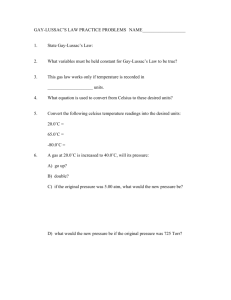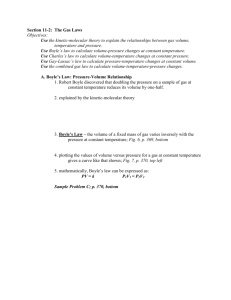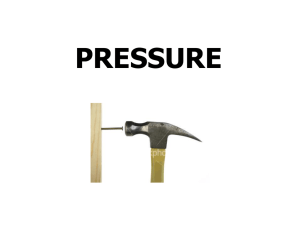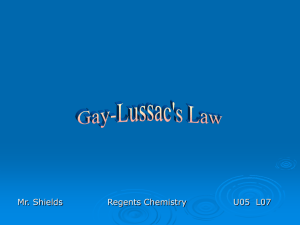Gas Laws Notes
advertisement
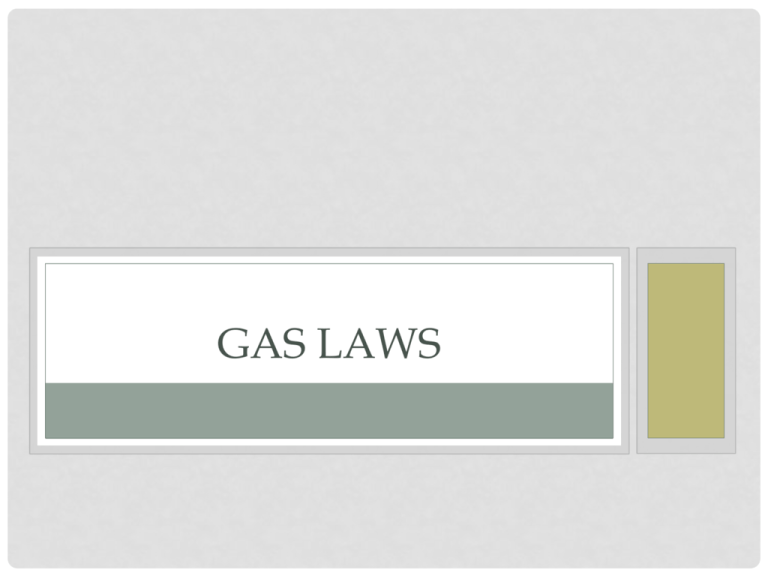
GAS LAWS BOYLE’S LAW DEMO Bell Jar and Marshmallow - The marshmallow is getting bigger (expanding – volume increases). Why? How do volume and pressure relate to each other? SHAVING CREAM DEMO WHAT IS BOYLE’S LAW? • The volume of a given amount of gas varies inversely with its pressure if the temperature remains constant • Inverse Relationship – as pressure increases, the volume decrease by the same factor • Example: If pressure doubles, the volume decreases by ½ • Example: If the pressure decreases by a factor of 4, Quadruple the volume will _____________. BOYLE’S LAW Formula: P1V1 = P2V2 • Remember, if pressure increases from P1 to P2, then Decrease from V1 to V2. volume must _________ • So, if pressure decreases from P1 to P2, then volume Increase from V1 to V2. must _________ BOYLE’S LAW GRAPH BOYLE’S LAW EXAMPLE • A sample of helium gas in a balloon is compressed from 4.0L to 2.5L, at a constant temperature. If the pressure of the balloon started at 210kPa, what will the final pressure (P2) be? BOYLE’S LAW EXAMPLE ANSWER • Formula: P1V1 = P2V2 • What do we know? • • • • P1 = 210 kPa V1 = 4.0 L P2 = ______ V2 = 2.5 L (210kPa)(4.0L) = (P2)(2.5L) P2 = 336 kPa CHARLES’ LAW DEMO Erlenmeyer Flask and a balloon Why does the balloon expand? How do temperature and volume relate to each other? WHAT IS CHARLES’ LAW? • The volume of a given mass of gas is directly proportional to its Kelvin temperature when held at constant temperature • Direct Relationship – as temperature increases, the volume increases by the same factor CHARLES’ LAW GRAPH CHARLES’ LAW Formula: V1 = V2 T1 T2 • Remember, if pressure increases from P1 to P2, then Increase from V to V . volume must _________ 1 2 • So, if pressure decreases from P1 to P2, then volume Decrease from V to V . must _________ 1 2 CHARLES’ LAW EXAMPLE • A gas sample at 40.0oC occupies a volume of 2.32L. If the temperature is raised to 75.0oC, what will its volume be? (always assume the 3rd variable is constant if it is not mentioned) (K = oC + 273) What is absolute zero? Why do we use Kelvin instead of Celsius degrees when working with gases? Temperature must be in Kelvin! K = oC + 273 CHARLES’ LAW EXAMPLE ANSWER Formula: V1 = V2 T1 T2 • What do we know? • • • • V1 = 2.32 L T1 = 40.0o C V2 = ______ T2 = 75.0o C We must convert from degrees Celsius to Kelvin (K = oC + 273) • T1 = 40.0o C + 273 = 313 K • T1 = 75.0o C + 273 = 348 K 2.32 L = V2 313 K 348 K V2 = 2.58 L GAY-LUSSAC’S LAW DEMO Egg in a bottle WHAT IS GAY-LUSSAC’S LAW • The pressure of a given mass of gas varies directly with the Kelvin temperature when the volume remains constant. • Direct Relationship – as temperature increases, the volume increases by the same factor GAY-LUSSAC’S LAW Formula: P1 = P2 T1 T2 • Remember, if pressure increases from P1 to P2, then Increase from T1 to T2. temperature must _________ • So, if pressure decreases from P1 to P2, then Decrease from T to T . temperature must _________ 1 2 GAY-LUSSAC’S LAW GRAPH Temperature (K) 150 300 450 Pressure (atm) 1.0 2.0 3.0 GAY-LUSSAC’S LAW Real World Example Pressure cooker is sealed so that the volume is constant. Pressure increases in the cooker as temperature increases GAY-LUSSAC’S LAW EXAMPLE The pressure of a gas tank is 3.20atm at 22oC. If the temperature raises to 60oC, what will be the pressure in the gas tank? Temperature must be in Kelvin! K = oC + 273 GAY-LUSSAC’S LAW EXAMPLE ANSWER Formula: P1 = P2 T1 T2 • What do we know? • • • • P1 = 3.20 atm T1 = 22.0o C P2 = ______ T2 = 60.0o C We must convert from degrees Celsius to Kelvin (K = oC + 273) • T1 = 22.0o C + 273 = 295 K • T1 = 60.0o C + 273 = 333 K 3.20 atm = P2 295 K 333 K P2 = 3.61 atm


